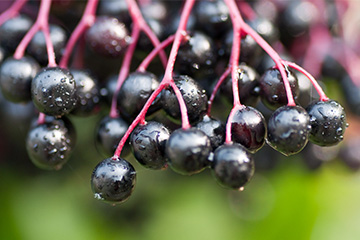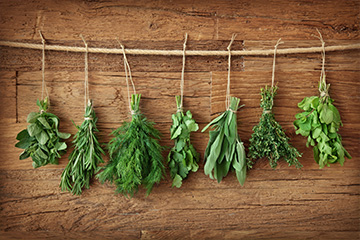
Elderberries: beautiful to look at, not for canning

Although elderberry plants are beautiful, recent variety tests have indicated that elderberries are low in acid and cannot be safely preserved using standard home-canning recommendations for fruits or berries.
Researchers investigated various varietal characteristics of 12 different genotypes of elderberry (Sambucus spp.) grown in Oregon and Missouri. Over 400 samples were analyzed (n=429) for characteristics such as fruit pH, soluble solids, and titratable acidity, and research was published in Acta Hortic. in January of 2015. The average pH of the fruit was 4.92 across all varieties and samples, with a range of 4.73 to 5.19. Assuming someone uses a research-tested recipe, the maximum pH for safe canning of fruits and fruit products is 4.60. This means that elderberries are low in acid and cannot be safely made into syrup or the berries canned using Extension-recommended recipes. The one exception is the canning of elderberry jam or jelly as long as you weigh ingredients and follow these special precautions:
- For jam, the weight ratio of elderberry pulp to sugar must be no more than: weight of fruit/ weight of sugar = 47/55 = 0.85. For every 16 ounces (1 pound) of fruit pulp for Jam, your recipe must include at least 18.9 ounces, by weight, of sugar. It is not acceptable to use dry measure cups or assume that a 1-cup measure of fruit or sugar weighs 8-ounces, it will not. You must weigh ingredients.
- For Jelly, the weight ratio of elderberry juice to sugar must be no more than: weight of fruit juice/ weight of sugar = 45/55 = 0.82. For every 16 ounces (1 pound) of fruit juice for Jelly, your recipe must include at least 19.5 ounces, by weight, of sugar. A lower ratio is acceptable; this means that you are adding more than the minimum amount of sugar and that is great for safety.
- Lemon juice added in some jam and jelly recipes is to help pectin form a gel; it cannot be relied on to provide a pH low enough to prevent botulism but is essential for a quality product. Besides fruit/juice and sugar, add lemon juice and pectin if you are making elderberry jam or jelly.
- Do not use honey as a sugar source.
- Do not use low-sugar or no-sugar added pectin or vary these weight proportions of fruit/juice to sugar, an unsafe product may result.
What about adapting recipes for canning berries by adding acid, or perhaps pressure canning? Extension-recommended recipes rely on laboratory research to ensure that recommendations produce products that are safe and of high quality. There are no research studies that have been conducted to indicate how much acid, or what kind, would be needed to safely can elderberry products using a boiling water or an atmospheric steam canner. Likewise, pressure canning methods have not been tested for elderberry products that would ensure a safe result (with or without added acid). If you wish to preserve elderberry fruit or juice, Extension recommends freezing as a safe alternative. Once thawed, the fruit or juice should be stored in the refrigerator and used within a few weeks.
Source: https://www.ncbi.nlm.nih.gov/pmc/articles/PMC4859753/
Article shortened and reprinted with permission from https://fyi.extension.wisc.edu/safefood/2020/06/05/elderberries-beautiful-to-look-at-not-for-canning/
Save Herbs for Cooler Seasons

Fresh herbs add flavor and presentation to different dishes during the summertime. Carry those great flavors past the lifespan of your plants by drying your excess herbs. Harvest the herbs in the early morning when they are at their maximum flavor, and prepare them by rinsing with cool water, and shaking off the excess moisture. Herbs can be dried in different ways:
Dehydrator – The best practice is to dehydrate herbs is with controlled temperature and air circulation. Preheat dehydrator to between 95- and 115-degrees Fahrenheit. Place herbs in a single layer on dehydrator trays and dry between 1 to 4 hours. Be sure to read the dehydrator instruction manual.
Air Drying – To air dry, tie sturdy herbs like rosemary, thyme, parsley, and sage together into small bundles and hang them to air dry. Tender leaf herbs (such as basil, oregano, and mint) should be hung inside paper bags to dry due to higher moisture content since they can mold easier. Tear holes in the sides of the bag, suspend the bunch in middle, and close the top with a rubber band.
Microwave drying – only use to dry 1 to 2 cups of herbs at a time. Herbs should be single layered in between two paper towels and dried for 1 to 4 minutes depending on the wattage of the microwave. Check every 30 seconds to prevent scorching.
Herbs are dry when leaves are crispy and crumble easily between the fingers. Store whole or crumpled herbs in an airtight container. They are good for up to 3 months in the cupboard and up to 1 year in the refrigerator or freezer. When substituting dried herbs for fresh herbs in recipes, use ¼ to ? of the listed amount.